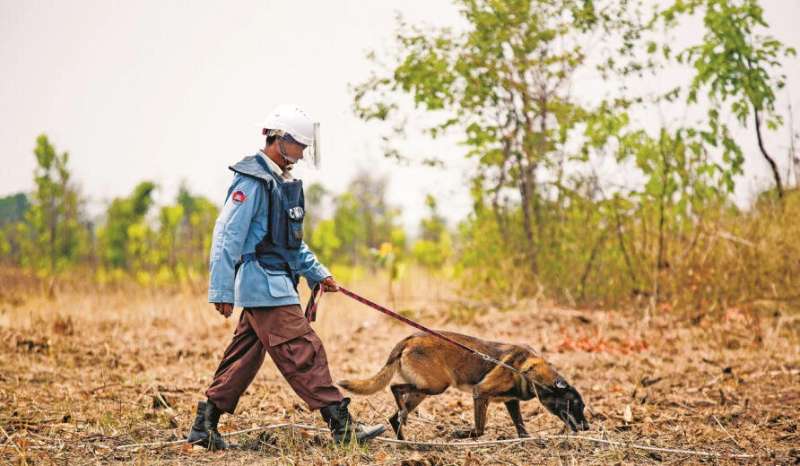Treatments for parasites keeping landmine detection dogs in field

Cambodia is a country that remains plagued by landmine contamination. As a result, the country has a high proportion of physically disabled people in its population, which has a huge impact both socioeconomically and psychologically.
Thankfully, specially trained mine detection dogs, that have been used since the early 2000s, do an amazing job of sniffing out landmines to make land safe for occupation and agriculture.
But these specialist dogs, as well as pet and stray dogs in the country, suffer from infestation with parasites—like ticks, fleas and lice that can transmit a large range of potentially deadly diseases.
Tick-borne pathogens (TBPs) are the most significant of these and are responsible for many dogs becoming ill or dying in Cambodia, as well as more generally across tropical regions of the Asia-Pacific.
Because of this risk, products—called chemopreventives—that protect dogs from parasites and prevent them catching the diseases they transmit are crucial.
Our field work in Cambodia has been putting these chemopreventive products to the test to see how well they work at preventing mine detection dogs and pet dogs from catching TBPs.
However, not all chemopreventive products are created equally.
One group of chemopreventives, known as topically acting products, acts on the skin and fur of an animal to stop ticks biting by either repelling or quickly killing them on contact.
A second group of chemopreventives, called systemically acting products, are absorbed into the dog's bloodstream and only kill ticks after they have bitten and taken a blood meal.
Published in Current Research in Parasitology & Vector-Borne Diseases, our study first compared the number of TBP infections in dogs given a topically acting, systemically acting or no chemopreventive product. We found that for dogs on systemically acting products, the number of infected individuals was almost three times higher than those on topically acting ones, while infections were higher still in dogs on no parasite control.
As systemically acting products allow ticks to feed before killing them, it appears they provide an opportunity for transmission of TBPs.
In countries like Cambodia, our data highlights the need for the use of topically acting products that kill and/or repel ticks before they bite. This is a message that's especially important given the popular use of systemically acting products in tropical parts of the Asia-Pacific, including Australia.
The second part of our research directly compared two different topical chemopreventive products in the field, using both mine detection dogs and pet dogs.
Our team evaluated one product, a Seresto collar (containing imidacloprid and flumethrin) that has been demonstrated to protect dogs from brown dog ticks for up to eight months, with a monthly spot-on treatment called Detick (fipronil) which is commonly available throughout Southeast Asia.
We conducted this trial over one year in close collaboration with Animal Mama Veterinary Hospital and the Cambodian Mine Action Center (CMAC).
In the second part of the study, we again saw a large benefit of the topically acting products for preventing ticks and their diseases. Newly acquired TBPs over the twelve month study period were as low as five percent for the dogs on Seresto collars and seven percent for those on Detick.
This is a remarkable result given that the prevalence of these diseases was recently found to be as high as 62 percent for stray dogs on no chemopreventive product in Cambodia. Although Seresto seemed to demonstrate a slightly increased protective benefit over Detick, both products appear to work well overall.
Our research is critically important to veterinarians and pet owners living in tropical regions of the Asia-Pacific as it shows that readily available topically acting chemopreventives can work effectively to kill ticks and reduce the risk of them transmitting diseases to dogs.
Our findings are vital for non-government organizations (NGOs) using landmine detection dogs in Cambodia because it costs around $US 30,000 over two years to train every working dog.
If a landmine detection dog becomes sick with TBPs they are forced out of their landmine detection duties, which comes at a great cost to mine clearance efforts. In some cases, they can even die, despite treatment.
So, knowing which chemopreventive products work effectively in the tropics is crucial.
The implications of our research are also important here in Australia—particularly in the country's northern tropical regions where ticks are most common.
This has been highlighted by the recent introduction of the deadly disease canine ehrlichiosis caused by the tick-transmitted bacteria Ehrlichia canis.
Since 2020, when ehrlichiosis was first identified in Western Australia, the disease has now spread to the Northern Territory, with cases also found in South Australia and Queensland.
Research like ours, and that of others in the field, shows how topically acting chemopreventive products can protect all dogs—including those detecting landmines in Cambodia—from ticks, stopping them from becoming ill.
It's a finding that we hope will lead to greater safeguarding of dog health well into the future.
More information: Lucas G. Huggins et al, Field trial investigating the efficacy of a long-acting imidacloprid 10%/flumethrin 4.5% polymer matrix collar (Seresto®, Elanco) compared to monthly topical fipronil for the chemoprevention of canine tick-borne pathogens in Cambodia, Current Research in Parasitology & Vector-Borne Diseases (2022). DOI: 10.1016/j.crpvbd.2022.100095
Provided by University of Melbourne



















